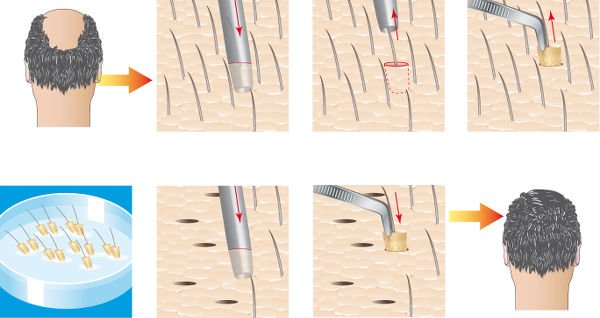The FUE technique for hair transplants is a minimally invasive, outpatient surgical procedure where hair follicles are extracted individually, without the need for removal of a strip of scalp tissue. It is an advanced technique with minimal scarring, no suturing and enables treatment of small and medium-sized areas.
The FUE technique is characterised by the special harvesting method of the follicular units for transplanting. It is conducted by means of a punch or perforating tool. The advantage of this system is that there is no scarring on the donor site, which is important for patients with very short hair.
The punches used in follicular unit extraction measure 0.6 to 0.8 mm in diameter, leaving invisible micro-scars following unit extraction.

The FUE technique is indicated in the following cases:
The FUT by strip technique is still the method of choice for the vast majority of patients. More follicular units can be grafted with this technique.
The main restriction to the FUE technique is limitations to the number of units that can be implanted in each session, since the extraction process of each follicular unit is slower compared to other techniques.
Follicular unit extraction is a delicate technique that requires a high level of surgeon training, working with optical magnification to accurately detect the follicle implantation angle and follow its trajectory as the punch is inserted into the skin. The angle of the sprouting hair is generally more acute than the implantation angle of the follicle in the dermis. This makes it essential for the punch to follow the follicle orientation instead of the direction of the hair.

The FUE technique is indicated in small areas
The punch used for this is 0.8 mm in size, which is sufficient diameter to not disturb the structure of follicular units made up of more than one hair follicle. The added advantage is the resulting undetectable micro-scars.
The punch is inserted into the skin and twisted slightly while applying pressure to pierce the skin. These measures are essential to keep the transection rate low and yield a maximum number of viable follicular units.
It is important for the physician to discuss the suitability of applying the FUE technique with each patient. The follicles should not be too tightly held by the piloerector muscle for the technique to be viable.
With the FUE technique, the follicle protuberance area is not detectable, which is essential for survival of the follicular unit once transplanted. This is because the extraction procedure is a blind harvesting technique.
It is also important for the surgeon to take into account the different depths of the hair follicles that are closest to each other on the skin surface during the extraction phase. This means that the implantation direction of the whole hair follicle is not linear. Therefore, during the punch extraction procedure, the surgeon must change the angle once the surface portion of the follicle has been surpassed.
Once they are completely separated, the follicular units are gently harvested to avoid trauma in the follicular structures.
The FUE technique for hair grafts is conducted following these steps:
Hair on the donor site is shaved to a length of 1 or 2 mm. Shaving the donor area is indispensable for FUE, therefore patients who are not willing to have that area shaved cannot be treated with this technique.
The patient lies face down on the bed. Local anaesthesia is applied to the donor site, so the patient remains awake and conscious throughout the procedure.
The follicular units are extracted from the donor site with an 0.8 to 1 mm punch with the aid of a magnifying glass.
The punch is introduced into the skin, threading the emerging hair and facing the punch in the assumed direction of the hair follicle in the dermis and hypodermis. When the punch has bound the length of the follicular unit, it is then gently extracted with the aid of precision pliers.
The grafts are selected, checked and kept under a holding solution.. They are sorted by the number of follicles in each follicular unit and placed in a saline or lactated Ringer's solution until they are ready for grating.
The extracted follicular units have 1 to 5 follicles with each punch insertion.

Hair grafting steps with the FUE technique
The grafting procedure is the same as for the FUT technique.
Tiny slits are made to the recipient area where the follicles will be grafted. Several aspects have to be considered that will influence a result with maximum density and a natural appearance:
The FUE technique requires a high level of surgeon training, the integrity of the follicles should be carefully guarded when extracting.
The patient should also be aware that the FUE technique is considered to be 3 times slower than the FUT technique for the same number of grafts, due to the delicate nature of the extraction stage.
A typical FUE works with 1200 follicular units. Should the patient require a higher number, the FUE technique has to be conducted in several sessions on consecutive days.
The advantage of FUE is that it leaves no visible scarring. For a larger number of grafts, treatment can be arranged over two days, enabling FUE of a greater amount of grafts.
Would you like to know if the FUE technique is suitable for you? Request a free informative consultation now with one of our expert surgeons from the IML Hair Transplant Unit.